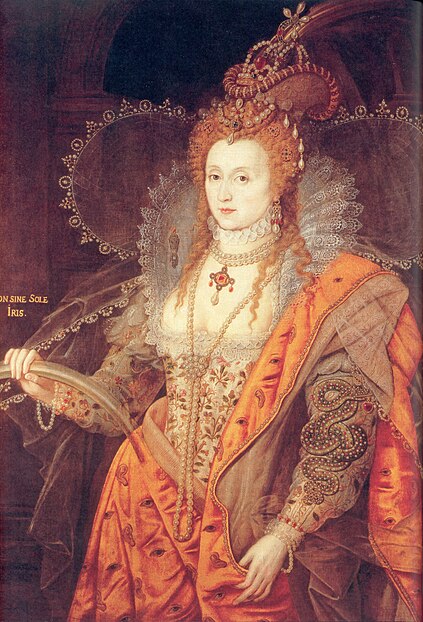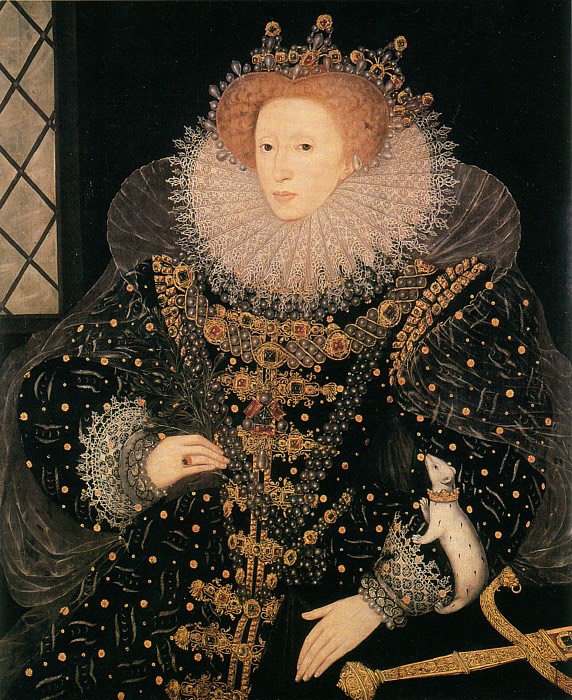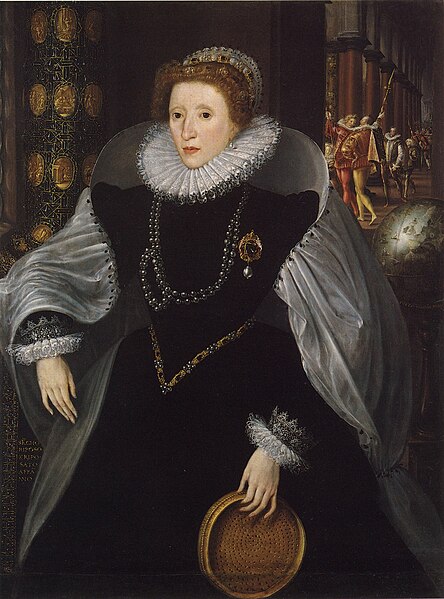 |
http://en.wikipedia.org/wiki/File:Elizabeth_I_Rainbow_Portrait.jpg
The Rainbow Portrait of Queen Elizabeth I
c.1600-1602
Attributed to Issac Oliver (1556-1617)
Oil on canvas
127 × 99.1 cm (50 × 39 in)
|
The rainbow portrait was drawn when Elizabeth was about 60 years old and as you can see, she still looks very young and ageless which shows her image of being a 'Fairy Queen'. The crescent shaped jewel that Elizabeth wore around the neck which represents goddess of the moon, symbolise feminine authority within the portrait. On this portrait, Elizabeth has got curly frizzy ginger hairstyle and the hair was half up and half down (maybe to show her virginity). The hairstyle was highly decorated with jewels such as pearls to show purity and wealth. She also wears a clown to show royalty and power.
 |
| http://www.gogmsite.net/_Media/1585-elizabeth-ermine-portr-2.jpeg The Ermine Portrait of Queen Elizabeth Ic.1585 By Nicholas Hilliard |
 http://en.wikipedia.org/wiki/File:Metsys_Elizabeth_I_The_Sieve_Portrait_c1583.jpg Sieve Portrait of Queen Elizabeth 1583 Oil on panel By Quentin Metsys the Younger |
 |
| http://www.elizabethfiles.com/wp-content/uploads/2010/06/Elizabeth_I_Armada_Portrait_450x372.jpg The Armada Portrait of Queen Elizabeth I circa. 1588 by an unknown artist |
This portrait was painted when Elizabeth was around 55 years old and she still looks youthful. She poses powerfully and the big clothes symbolise the wealth, high status and purity. In the portrait, the pearls that Elizabeth wears is Robert Dudley's last gift to Elizabeth and it has a very special meaning to her. The pearls symbolise purity and wealth in the Elizabethan era. This portrait also features the globe as well, like 'the Sieve Portrait'. But this time, Elizabeth's hand is on the globe and her fingers are extending to other parts of the globe which symbolises that Elizabeth's power is far reaching.
The egg shaped object in front of the window symbolise rebirth, fertility, eternal life, prosperity, generosity and union. Outside the windows are the scene where on the left window is the arrival of the Armada and on the right window is the defeat of the Armada. This portrait could also been seen to describe Elizabeth's success at protecting the nation from Spanish invasion. The crown on the left of the portrait symbolise royalty and majesty. The large bows on Elizabeth's clothes symbolise virginity in this portrait. Elizabeth's hair features a heart shape which was done through the use of padding and it is decorated with pearls which shows purity and wealth. She wears a crown to show royalty and power and it is decorated with feather (maybe to show high status).
No comments:
Post a Comment